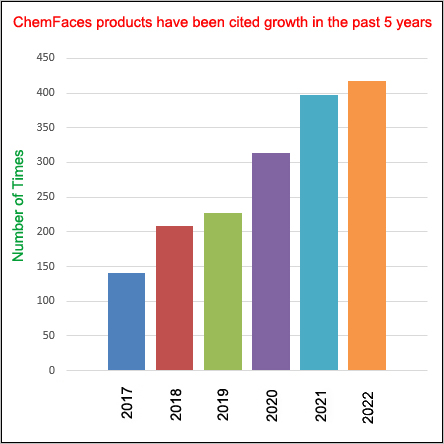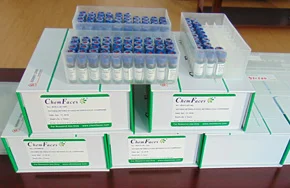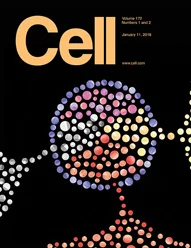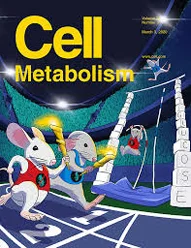| Description: |
Artemisinic acid, is the immediate precursor of the semi-synthesis artemisinin, could be a cost-effective, environmentally friendly, high-quality and reliable source of artemisinin. Artemisinic acid has a variety of pharmacological activity, such as antimalarial, anti-tumor, antipyretic, antibacterial, allelopathy and anti-adipogenesis effects. Artemisinic acid is a regulator of adipocyte differentiation and C/EBP δ expression, it inhibits adipogenic differentiation of hAMSCs through reduced expression of C/EBP δ; it inhibits melanogenesis through downregulation of C/EBP α-dependent expression of HMG-CoA reductase gene.
|
| In vitro: |
| J Cell Biochem. 2012 Jul;113(7):2488-99. | | Artemisinic acid is a regulator of adipocyte differentiation and C/EBP δ expression.[Pubmed: 22396222] | Adipocyte dysfunction is associated with the development of obesity. In this study, Artemisinic acid, which was isolated from Artemisia annua L., inhibited adipogenic differentiation of human adipose tissue-derived mesenchymal stem cells (hAMSCs) and its mechanism of action was determined.
METHODS AND RESULTS:
The mRNA levels of peroxidase proliferation-activated receptor (PPAR) γ and CCAAT/enhancer binding protein (C/EBP) α, late adipogenic factors, were reduced by Artemisinic acid. Moreover, the mRNA levels of the PPAR γ target genes lipoprotein lipase, CD36, adipocyte protein, and liver X receptor were down-regulated by Artemisinic acid. Artemisinic acid reduced expression of the C/EBP δ gene without impacting C/EBP β. In addition, attempts to elucidate a possible mechanism underlying the Artemisinic acid-mediated effects revealed that reduced expression of the C/EBP δ gene was mediated by inhibiting Jun N-terminal kinase (JNK). Additionally, Artemisinic acid also reduced the expression of the adipogenesis-associated genes glucose transporter-4 and vascular endothelial growth factor. In addition to the interference of Artemisinic acid with adipogenesis, Artemisinic acid significantly attenuated tumor necrosis factor-α-induced secretion of interleukin-6 by undifferentiated hAMSCs, thus influencing insulin resistance and the inflammatory state characterizing obesity.
CONCLUSIONS:
Taken together, these findings indicate that inhibiting adipogenic differentiation of hAMSCs by Artemisinic acid occurs primarily through reduced expression of C/EBP δ, which is mediated by the inhibition of JNK and suggest that aremisinic acid may be used as a complementary treatment option for obesity associated with metabolic syndrome. | | Current Science, 2000 , 78 (6) :709-713. | | Antimicrobial activity of artemisinin and its precursors.[Reference: WebLink] | Artemisinic acid and Arteannuin B are biogenetic precursors of Artemisinin, an important antimalarial produced by the herb Artemisia annua. These compounds have been screened for antimicrobial activity against a range of organisms.
CONCLUSIONS:
All the three compounds are active against different bacteria and certain fungal species |
|






 Cell. 2018 Jan 11;172(1-2):249-261.e12. doi: 10.1016/j.cell.2017.12.019.IF=36.216(2019)
Cell. 2018 Jan 11;172(1-2):249-261.e12. doi: 10.1016/j.cell.2017.12.019.IF=36.216(2019) Cell Metab. 2020 Mar 3;31(3):534-548.e5. doi: 10.1016/j.cmet.2020.01.002.IF=22.415(2019)
Cell Metab. 2020 Mar 3;31(3):534-548.e5. doi: 10.1016/j.cmet.2020.01.002.IF=22.415(2019) Mol Cell. 2017 Nov 16;68(4):673-685.e6. doi: 10.1016/j.molcel.2017.10.022.IF=14.548(2019)
Mol Cell. 2017 Nov 16;68(4):673-685.e6. doi: 10.1016/j.molcel.2017.10.022.IF=14.548(2019)